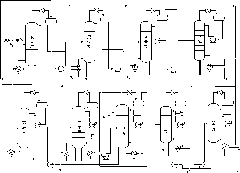Energy-saving water-saving organic silicon monomer rectifying method
An organosilicon and water-saving technology, which is applied in organic chemistry, silicon organic compounds, chemical instruments and methods, etc., can solve the problems of large loss of excess monomer and A, and achieve reduced evaporation loss, more control means, and lower circulation The effect of water volume
- Summary
- Abstract
- Description
- Claims
- Application Information
AI Technical Summary
Problems solved by technology
Method used
Image
Examples
Embodiment 1
[0022] The overhead material steam of the decontamination tower first enters the distribution manifold, and then passes through the distribution manifold to the towers of the decontamination tower, the light separation tower, the hydrogen-containing tower, the azeotropic tower, the top three towers, the first top tower, and the second top tower. The bottom reboiler supplies heat. After heating, the top material vapor of the de-elevation tower is condensed into a liquid which is cooled to the reflux temperature by an air cooler and enters the top reflux tank of the de-elevation tower. The bottom of the dimethyl tower is connected with a first Two reboiler, the second reboiler adopts steam heat exchange, the average operating pressure of the whole tower of the de-elevation tower is 300KPa, the temperature of the bottom of the tower is controlled at 135°C, and the temperature of the top of the tower is controlled at 120°C; The average operating pressure of the entire tower of the f...
Embodiment 2
[0025] The overhead material steam of the decontamination tower first enters the distribution manifold, and then passes through the distribution manifold to the towers of the decontamination tower, the light separation tower, the hydrogen-containing tower, the azeotropic tower, the top three towers, the first top tower, and the second top tower. The bottom reboiler supplies heat. After heating, the top material vapor of the de-elevation tower is condensed into a liquid which is cooled to the reflux temperature by an air cooler and enters the top reflux tank of the de-elevation tower. The bottom of the dimethyl tower is connected with a first The second reboiler, the second reboiler adopts steam heat exchange, the average operating pressure of the whole tower of the de-elevation tower is 500KPa, the temperature at the bottom of the tower is controlled at 125°C, and the temperature at the top of the tower is controlled at 130°C; The average operating pressure of the whole tower of...
Embodiment 3
[0028] The overhead material steam of the decontamination tower first enters the distribution manifold, and then through the distribution manifold to the bottom reboiler of the decontamination tower, light separation tower, hydrogen-containing tower, azeotrope tower, trimethyl tower and dimethyl tower respectively After heating, the vapor of the top material of the decontamination tower is condensed into liquid and then cooled to the reflux temperature by the air cooler and enters the top reflux tank of the decontamination tower. The bottom of the dimethyl tower is connected with a second reboiler , The overhead material steam of the first A tower supplies heat to the second reboiler of the second A tower, together with the first reboiler heated by the top steam of the decontamination tower, to maintain the operation of the second A tower. The top material steam of the first tower enters the top reflux tank of the first tower after heating, and the bottom reboiler of the first t...
PUM
 Login to View More
Login to View More Abstract
Description
Claims
Application Information
 Login to View More
Login to View More - R&D
- Intellectual Property
- Life Sciences
- Materials
- Tech Scout
- Unparalleled Data Quality
- Higher Quality Content
- 60% Fewer Hallucinations
Browse by: Latest US Patents, China's latest patents, Technical Efficacy Thesaurus, Application Domain, Technology Topic, Popular Technical Reports.
© 2025 PatSnap. All rights reserved.Legal|Privacy policy|Modern Slavery Act Transparency Statement|Sitemap|About US| Contact US: help@patsnap.com



